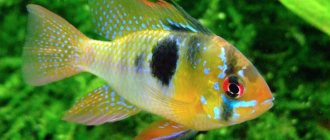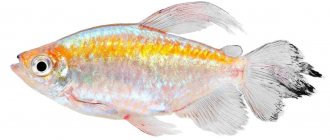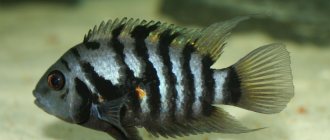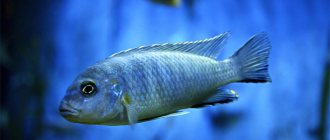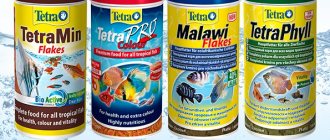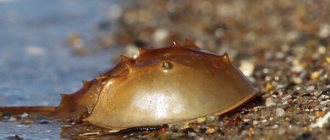The handsome chromis (lat. Hemichromis bimaculatus) is a cichlid that has become famous for its beauty and aggressive nature. Of course, if kept with guppies and zebrafish, he is aggressive. But, if you keep it with a fish of suitable size and character, then it won’t bother anyone too much. The only exception is during spawning, but a fish that protects its eggs cannot be considered evil?
Description
Beautiful chromis have an elongated body measuring 12–15 cm. The sides, fins and body are covered with greenish or bluish round spots. The appearance of the handsome varieties differs in the location of dark spots on the body. Everyone has one in the middle of their torso. The second spot near the anus of a two-spotted beauty. On the gills of hybrid species. In sexually mature individuals they sometimes disappear.
Most often the color is red. Shades from bright carmine to pink-orange. The back of handsome men is usually dark olive. The sides are greenish-pink.
The dorsal and anal fins are pointed. The caudal fin is rounded. The dorsal is long, occupies almost the entire back. The beauties are also called pearl cichlids, because of the blue luminous spots that cover the body and fins.
Features of behavior
Chromis handsome (hemichromis, red cichlid) has an aggressive character. They tend to undermine the soil and gnaw plants. Only hard-leaved species are selected.
When moving into a new aquarium, it takes 15–20 days to get used to it. During the adaptation period they are fearful. Housing conditions should be similar to the previous one.
After getting used to it, they divide the territory and drive away strangers. Even members of their own species. Therefore, there must be shelters in the reservoir where growing males and females can hide from mature individuals.
When they spawn, belligerence increases. During spawning, the partner sometimes kills the weak one. There are also peaceful-minded individuals. But the look is very aggressive.
Lifespan
The average lifespan of the chromis beauty fish in captivity is 4–5 years.
Living in the natural environment
Domestic aquarists liked this wayward inhabitant, they called it handsome chromis and red cichlosoma. At first, this name meant two species of fish - H. guttatus and H. bimaculatus. Representatives of the first variety had a tall body, and the second had two dark spots. But the chromis were more accurately identified later, thanks to the painstaking work of Günter Störbow.
In nature, the handsome chromis lives in the waters of Central Africa - the Nile, Congo, and Niger rivers. The fish is also common in the coastal areas of lakes and rivers in Central Liberia and Southern Guinea. In the Congo River, chromis have become thoroughly established; these fish can only be found in Kasai and Katanga.
These cichlids are highly adaptable and thrive in both soft and hard waters. The Congo River has very muddy water, but it contains a high concentration of oxygen.
Kinds
There are four popular types of fish that are classified as handsome.
- Hemichromis Bimaculatus. Two-spotted, characteristic dark spots near the caudal fin.
- Hemichromis Guttatus. Tall-bodied, without dark spots, like the two-spotted one.
- Hemichromis lifalili. Different form of dorsal fin, no spot near the tail. This species is considered a real beauty of chromis. It is more peaceful than the tall-bodied or two-spotted.
- Hemichromis Bimaculatus II. An artificially bred subspecies. Very bright red color.
How to determine gender
Sex differences in chromis are practically not visible. But since fish will reproduce only in the presence of an established partner, by and large it is not so important where in the pair the male is and where the female is. They stay together everywhere, prepare the nest, and protect the eggs. With particularly close observation, you can notice a characteristic feature of cichlids: the male has a sharper and longer dorsal fin. Trying to pair fish from more than one pair will result in the male driving the female or beating her to death.
Content
With the right selection of neighbors and plants, keeping chromis fish does not require much effort. Use an aquarium with a size of 60 liters, and preferably 120–200 liters. The fish needs space. They love to hide, so take care of places for shelter: snags, grottoes, broken pots, caves.
Beauties need clean water, so change the liquid 25-30% weekly. Use a standard set of equipment: aerator, lighting, heater, external filter (internal, given the habit of breaking up the soil, is not suitable).
Water
| temperature | 22–28°C |
| acidity | 6,0–7.5 pH |
| rigidity | 4–12 dH |
These are ideal conditions. But hemichromis are able to adapt to more severe conditions.
Plants
Red cichlids dig the soil, tearing out plants and algae with roots, and gnaw leaves. Therefore, when planting plants in an aquarium, select ones with a powerful root system and hard leaves that can withstand attack. Use Anubius for planting. It fits better.
You can also use other hard-leaved species with creeping and strong roots. Or strengthen the roots with heavy stones when planting. Some aquarists bury plants already planted in a pot in the soil of the aquarium.
Priming
For soil, use stones: crushed stone, fine gravel or pebbles. When using sand, the water will be cloudy due to constant swarming at the bottom. Clean the soil weekly to remove fish waste and debris.
Lighting
Lighting for red cichlids should be bright, especially during the spawning period, but the aquarium must have shaded areas. Use fluorescent lamps.
General information
Coils (Planorbidae) are a family of freshwater gastropods, widespread on almost all continents. Some species are frequent inhabitants of home aquariums, getting here mainly by chance (spawn or young snails are usually carried on plants). Although some aquarists keep them purposefully for the sake of variety or as food for certain types of fish.
Coils are unusually hardy mollusks, can exist in various water conditions, and reproduce easily and quickly. These invertebrates can breathe in two ways - using oxygen dissolved in water and atmospheric air.
The coils can breathe both oxygen dissolved in water and atmospheric oxygen.
An interesting feature of the reels is the ability to move along the surface of the water with the shell down. The snails are helped to maintain balance by the air they draw into their shells when breathing. The support is the surface tension of water or a bacterial film. True, if you even slightly touch the snail at this time, it will immediately begin to sink. This allows them to escape from predators.
Coils are capable of multiplying very quickly, but this happens mainly in conditions of excess food, when the aquarist regularly overfeeds the fish.
The positive aspect of keeping coils is that these mollusks do not spoil plants, but they process dead leaves with a bang, being typical detritivores.
It is not recommended to bring coils from natural bodies of water into the aquarium. Gastropods are intermediate hosts of many types of parasites that are dangerous to fish.
Feeding
The aquarium fish Chromis has an excellent appetite. He eats a lot and whatever is given. Therefore, when feeding handsome chromis, calculate the serving size and stick to it. Otherwise, the fish will overeat and die.
Handsome animals are omnivores, but prefer animal protein foods. They are also carnivores, and their diet should include meat. The main foods for hemichromis are:
- live food - bloodworms, tubifex, fish fry, earthworms;
- meat - thin slices of beef, shrimp;
- chopped lettuce, pieces of cucumber, zucchini, food containing spirulina;
- artificial industrial food for cichlids.
If you do not have experience keeping such fish, then start with store-bought food for cichlids, and then gradually select the diet. Feed adult chromis once a day, sometimes twice. Fry and growing young fish 4-5 times a day. Give your chromis food in large pieces.
Calculate the size of one serving based on the volume of food eaten in 20 seconds.
Compatibility
Chromis need to be kept with large fish that can stand up for themselves. As a rule, these are other cichlids: black-striped, bees, turquoise acara, blue-spotted acara.
Any cichlids do not get along well with plants, and chromis have nothing to do in the herbalist. It is impossible to keep it with scalars. The latter will be regularly beaten and there will be nothing left of their gorgeous fins.
Reproduction
Breed beauties at home in a separate large-volume aquarium of 100 liters or more. It's called spawning. It is possible in general, but you need to protect the fry and neighbors in the aquarium, because during the spawning period, chromis are more aggressive than usual. The period of sexual maturity in the red cichlid occurs at 6–9 months.
Sex differences
It is difficult to visually distinguish a male from a female. Sex differences are not clearly expressed. Males have brighter colors and are larger in size. Female chromis have a more rounded abdomen.
Pair formation
When breeding beauties, the creation of a pair plays a major role. Because if the partners don’t get along, they can kill each other. The couple is created forever and remains monogamous. Buy a pair that has already been created in the store.
If you are planning to raise handsome dogs on your own and create a couple, then start by getting to know each other. For example, in an aquarium through a barrier or glass. When the male and female do not show aggression towards the partner, then they can proceed to spawning.
Preparing for spawning
Place large flat stones on the ground in the aquarium. The eggs will be laid there. For stimulation, increase the water temperature to 27–29°C. The medium must be neutral or slightly acidic.
Spawning
When the pair has formed, spawning begins. In males the color becomes brighter. And blue or green spots begin to glow. But not for all individuals. He begins to form shelters, dig holes, and clears flat stones of debris.
Interesting Facts
- Handsome chromis are monogamous creatures; from the beginning of puberty they form a stable married couple. And at the same time, chromis tend to clearly delineate their territory and protect its borders. For two pairs of beautiful chromis, it is worth purchasing a large aquarium and placing a tall piece of driftwood on the bottom. Over time, fish will begin to redistribute the bottom space along this boundary.
- Young beautiful chromis, which have never spawned, have a rather modest coloration. After puberty, the fish immediately find a mate and begin to reproduce. The fertility of these creatures is so great that Günther Sterba (German zoologist and amateur ichthyologist) called them “a generator of new fish.”
- About 20 years ago, aquarists more than once noted the destruction of females by males in cases where the pair did not suit each other. In the literature of those years, it was strongly recommended to keep a couple of these fish separately from all other fish, they become so aggressive during spawning.
Chromis diseases
Beautiful chromis have good health, but failure to comply with the rules of maintenance and care leads to illness. When performing scheduled water changes, use special tests to check the water quality. High levels of nitrates and ammonia reduce immunity.
If your fish gets sick, move it to a separate aquarium so as not to infect your neighbors. For treatment, raise the water temperature to 31°C and add salt to the pond in a ratio of 5 g of salt per 1 liter of water.
Sometimes the cause of the disease is stress, aggression from neighbors, or a small aquarium.
Breeding
The reproduction of these fish is quite interesting. So, just before the start of spawning, the male selects a mate with whom he will spawn. It would seem that there is nothing unusual here, but this is where the main difficulty lies, since if the choice is made incorrectly, these aquarium fish can also kill each other. Therefore, in order for their breeding to occur successfully, in the first days after the formation of pairs, it is necessary to very carefully observe the fish - how reproduction will occur. Also, experienced aquarists recommend using larger and older males as prospective partners for females, photos of which can be seen below.
After all the pairs have formed, it is necessary to remove the remaining applicants from the artificial reservoir in order to avoid their death.
Reviews
Owners of red cichlids complain about the fish’s aggression and pay attention to the choice of aquarium inhabitants. Plants are severely destroyed and artificial ones are used.

